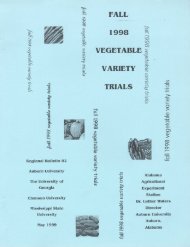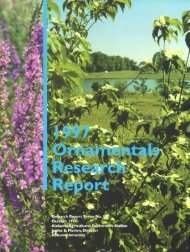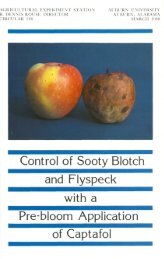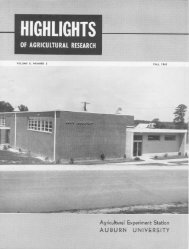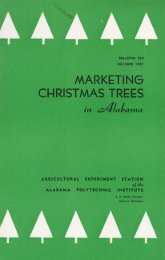Thinning with the John Deere 743A - Auburn University Repository
Thinning with the John Deere 743A - Auburn University Repository
Thinning with the John Deere 743A - Auburn University Repository
You also want an ePaper? Increase the reach of your titles
YUMPU automatically turns print PDFs into web optimized ePapers that Google loves.
F,<br />
rl<br />
Alabama Agricultural Experiment" Station<br />
David H. Teem, Acting Director<br />
Iuotin 573<br />
S<br />
E<br />
I<br />
<strong>Auburn</strong> <strong>University</strong><br />
<strong>Auburn</strong> <strong>University</strong>, Alabama<br />
November 1985<br />
Y<br />
y I<br />
F r W ¢<br />
j F wx:<br />
i<br />
I i T4T Ii
CONTENTS<br />
Page<br />
STUDY CONDITIONS....................................................... 3<br />
METHODS .................................................................... 3<br />
RESULTS......................................................................5<br />
CONCLUSIONS............................................................... 8<br />
FIRST PRINTING, 3M, NOVEMBER 1985<br />
Information contained herein is available to all persons<br />
regardless of race, color, sex, or national origin.
<strong>Thinning</strong> <strong>with</strong> <strong>the</strong> <strong>John</strong> <strong>Deere</strong> <strong>743A</strong><br />
A Case Study<br />
Bobby Lanford, Bryce J. Stokes, and Ma<strong>the</strong>w Somerville'<br />
A STUDY of <strong>the</strong> <strong>John</strong> <strong>Deere</strong> (JD) <strong>743A</strong> 2 felling and<br />
bunching trees was conducted in eastern North Carolina during<br />
<strong>the</strong> summer of 1982. This was part of a larger study<br />
examining <strong>the</strong> operational characteristics and productivity of<br />
several feller-bunchers used in thinning applications. Two<br />
methods were examined: clearcutting every fifth row and<br />
selectively cutting (low thinning) from two rows on ei<strong>the</strong>r side<br />
of <strong>the</strong> clearcut rows.<br />
STUDY CONDITIONS<br />
The stand was a 21-year-old loblolly pine plantation <strong>with</strong><br />
an initial density of 680 trees per acre. It had been bedded<br />
prior to planting and, <strong>the</strong>refore, had good row alignment.<br />
Dense brush in <strong>the</strong> stand restricted visibility to less than 30<br />
feet. In both thinning methods, hardwoods were removed only<br />
for access.<br />
The JD <strong>743A</strong>, cover photo, is a 152-horsepower, rubbertired,<br />
swing-to-tree feller-buncher. A 5-foot boom extension<br />
increased <strong>the</strong> machine's reach to a maximum 22.5 feet. The<br />
felling head was a <strong>John</strong> <strong>Deere</strong> 'scoop' shear <strong>with</strong> an 18-inch<br />
capacity, see figure. Vehicle width was 10.6 feet <strong>with</strong> 30.5 X<br />
32-inch tires.<br />
METHODS<br />
Plots were set up to test differences between <strong>the</strong> two thinning<br />
methods. For <strong>the</strong> corridor cut, a section of row approximately<br />
860 feet in length was designated. All trees in this row were<br />
numbered, measured for diameter at breast height (dbh), and<br />
identified by species. Since rows were located on 12-foot<br />
centers, cutting a row resulted in corridors approximately 24<br />
feet wide. For <strong>the</strong> selective cut, a 1/5-acre plot was flagged<br />
'The authors are Associate Professor of Forestry; Research Engineer, Sou<strong>the</strong>rn<br />
Forest Experiment Station, U.S. Forest Service; and former Graduate Assistant of<br />
Forestry, respectively.<br />
2 Use of trade names and brands is for reader convenience and is not an endorsement<br />
by <strong>Auburn</strong> <strong>University</strong> or <strong>the</strong> U.S. Forest Service.
M<br />
4 '<br />
ALABAMA AGRICULTURAL EXPERIMENT STATION<br />
i<br />
<strong>John</strong> <strong>Deere</strong> <strong>743A</strong> scoop shear head.<br />
<strong>with</strong> all trees on <strong>the</strong> plot numbered and dbh and species<br />
recordIed. The trees from <strong>the</strong> corridor we rc cut and removedl<br />
before selectiv e thinning began.<br />
Alter <strong>the</strong> plots wxere established, <strong>the</strong> maclinme wxas v ideotaped<br />
while operating. The numbers of each ( ut tree NN'ere audiblx<br />
recordedl on <strong>the</strong> v ideotape wxhile <strong>the</strong> mach ine progressed<br />
through <strong>the</strong> plots. After c utt ing, stump (diameters andI total<br />
heights of felled trees wxere measur ed from a sample of trees<br />
so that local x olume tab~les ( ould be constructed by dblh and<br />
stump dijameter.<br />
Time studlx data wxere obtained bx x iewxing <strong>the</strong> v ideotape<br />
and measuring time wit h a stopwxatc h. A cycle c onsisted of<br />
mov ing andl/or swxingi ng to <strong>the</strong> first tree, shearing, mov ing<br />
and/or swinging to and shear ing ot additional trees in accumulation.<br />
moxving and/or swxinginug to bunlk ocat ion, (lumping,<br />
andl occ asionalI bunc h mainutenancie. Cx cle time xxas div ided<br />
into elements as follows: mov e to trtee, swxing to tree, shear,<br />
moxve to dump, swxing to dump, and ([ump 1 . If hothI boom and<br />
mac hinie mox emeitt ott urredi simul11taneouslx , it was recorded<br />
as machine mov ement. T[he moxve-to-tree andI swing-to-tree<br />
elements wxere combined into a single element. T[he moxvc-to-<br />
(lump and sxwing-to-dump elements wxere also combined. Time<br />
study' data wxere [placed into computer files along wxith tree
THINNING WITH THE JOHN DEERE <strong>743A</strong> 5<br />
data for analysis.<br />
Summary statistics were computed for <strong>the</strong> element and cycle<br />
times on a per tree basis for both thinning methods. A local<br />
volume equation was constructed using <strong>the</strong> sampled diameters<br />
and heights estimating cubic feet inside bark (i.b.) to a 3-inch<br />
top. From <strong>the</strong>se data, average productivity rates were developed,<br />
which when combined <strong>with</strong> a machine rate, provide<br />
estimates of cost per unit of production.<br />
RESULTS<br />
The average move-to-tree time was 0.05 minute per tree<br />
for both cutting corridors and select cutting, tables 1 and 2.<br />
Average swing-to-tree times were also nearly identical. Shear<br />
time for selective cutting was 0.02 minute per tree faster than<br />
that for corridor cutting. This statistically significant difference<br />
indicated greater difficulty in cutting <strong>the</strong> trees in <strong>the</strong> clearcut<br />
fifth rows, most probably a result of a larger average diameter<br />
in rows than in <strong>the</strong> selectively cut trees.<br />
There was a significant difference in move-to-dump time<br />
TABLE 1. CORRIDOR CUTTING WITH THE JD <strong>743A</strong><br />
Time per tree<br />
Element Standard<br />
Observations Mean deviation Range<br />
No. Min.<br />
Move to tree ................. 31 0.05<br />
Swing to tree ................. 31 .15<br />
Shear ...............................<br />
31 .06<br />
Move to dump ................ 31 .002<br />
Swing to dump ............... 31 .02<br />
Dump ..... ................ . 31 .05<br />
Move-swing to tree ......... 31 .20<br />
Min.<br />
0.03<br />
.04<br />
.02<br />
.005<br />
.02<br />
.02<br />
.07<br />
Min.<br />
0.02 - .16<br />
.08 - .27<br />
.04 - .11<br />
.0 - .021<br />
.004- .10<br />
.02 - .10<br />
.10 - .43<br />
Move-swing to dump ...... 31 .02 .02 .004- .10<br />
Total ...... ............. . 31 .33 .09 .23 - .68<br />
TABLE 2. SELECTIVE CUTTING WITH THE JD <strong>743A</strong><br />
Time per tree<br />
Element Standard<br />
Observations Mean deviation Range<br />
No. Min. Min. Min.<br />
Move to tree ................... 8 0.05 0.02 0.02- .09<br />
Swing to tree .................. 8 .15 .04 .09- .20<br />
Shear ...... ............... . 8 .04 .01 .03- .06<br />
Move to dump ................ 8 .02 .01 .01- .05<br />
Swing to dump.. 8 .01 .01 .0 - .03<br />
Dump ..... .................. 8 .03 .01 .02- .04<br />
Move-swing to tree ......... 8 .19 .05 .12- .28<br />
Move-swing to dump ...... 8 .04 .02 .02- .07<br />
Total ........................... 8 .30 .06 .20- .38
6 ALABAMA AGRICULTURAL EXPERIMENT STATION<br />
between <strong>the</strong> two thinning methods. When cutting <strong>the</strong> corridor,<br />
<strong>the</strong> operator would dump <strong>the</strong> load after accumulating <strong>the</strong> last<br />
tree <strong>with</strong> little movement of <strong>the</strong> machine. The operator carefully<br />
laid and spaced bunches in <strong>the</strong> select cutting to have<br />
adequate room for all <strong>the</strong> trees in <strong>the</strong> corridor <strong>with</strong>out overlapping<br />
<strong>the</strong> bunches. However, during cutting of <strong>the</strong> corridor<br />
going forward, <strong>the</strong> bunches had to be laid to <strong>the</strong> side of <strong>the</strong><br />
corridor. This resulted in longer swing-to-dump times per<br />
corridor cutting. For <strong>the</strong> study, swing-to-dump was not significantly<br />
different between <strong>the</strong> two methods, even though it<br />
took less time during <strong>the</strong> select cut while traveling backwards<br />
and dumping to <strong>the</strong> front.<br />
There was a significant reduction in <strong>the</strong> dump time element<br />
between <strong>the</strong> methods. It took more time to dump in <strong>the</strong><br />
corridor cutting because <strong>the</strong> bunches were laid into <strong>the</strong> stand.<br />
There was resistance from <strong>the</strong> crowns in laying <strong>the</strong> bunches<br />
on <strong>the</strong> ground.<br />
For <strong>the</strong> combined elements, <strong>the</strong>re was little difference between<br />
<strong>the</strong> cutting methods for <strong>the</strong> move-swing-to-tree time<br />
element, reflecting <strong>the</strong> slight difference found between <strong>the</strong><br />
individual elements. There was a significant difference between<br />
corridor and select cutting for <strong>the</strong> combined move-swing-todump<br />
element. It took twice as much time in <strong>the</strong> select cutting,<br />
due to <strong>the</strong> difference in <strong>the</strong> move-to-dump element.<br />
Even though select cutting took a little less time than corridor<br />
cutting, an analysis of <strong>the</strong> total time per tree showed<br />
no significant difference between <strong>the</strong> two cutting methods.<br />
The trade offs and variability among <strong>the</strong> individual elements<br />
tended to balance <strong>the</strong> total cycle time between <strong>the</strong> two cutting<br />
methods.<br />
As expected, average diameter was higher in <strong>the</strong> corridor<br />
cut than in <strong>the</strong> selective cut, table 4. This supports <strong>the</strong> con-<br />
TABLE 3. COMPARISON OF CUTTING METHODS WITH THE JD<strong>743A</strong><br />
Means per tree Percent<br />
Element Corridor Select difference<br />
Min. Min. %<br />
M ove to tree ................................ 0.05 0.05 0<br />
Swing to tree ............. .................. . .15 .15 0<br />
Shear ............................................. .06 .04 - 33.3'<br />
Move to dump ............ ................. . .002 .02 + 9.0'<br />
Swing to dump ......... ................... .. 02 .01 - 50.0<br />
D um p ............................................ 05 .03 - 40.0'<br />
Move-swing to tree ....................... 20 .19 - 5.0<br />
Move-swing to dump ................... .. 02 .04 + 100.01<br />
T otal ......................................... 33 .30 - 9.1<br />
'Significant difference at 1 percent level.
THINNING WITH THE JOHN DEERE <strong>743A</strong> 7<br />
clusion drawn earlier concerning <strong>the</strong> differences in shear time.<br />
Also, it is apparent that a relatively greater amount of hardwoods<br />
had to be cut in <strong>the</strong> corridor removal than in <strong>the</strong><br />
selective cut. Hardwoods were not considered merchantable<br />
and were avoided where possible. Selective cutting allowed<br />
greater freedom to avoid <strong>the</strong> hardwoods than did cutting<br />
corridors. Cut hardwoods were removed along <strong>with</strong> <strong>the</strong> pine.<br />
Table 5 gives a comparison of thinning methods based on<br />
cycle variables. Corridor cutting had greater productivity in<br />
terms of cubic feet per hour than did selective cutting. However,<br />
<strong>the</strong> situation was reversed when productivity was measured<br />
in terms of trees per hour. Selective cutting resulted in<br />
more production on a tree basis, probably because of <strong>the</strong><br />
greater average number of trees per cycle than corridor cutting.<br />
However, <strong>the</strong> greater average tree size cut in <strong>the</strong> corridors<br />
resulted in greater cubic feet production.<br />
Combining cost assumption in table 6 <strong>with</strong> <strong>the</strong> estimates of<br />
productivity in table 5 gives cost per cunit (i.e., cost per 100<br />
cubic feet of solid wood). The estimated cost for <strong>the</strong> JD <strong>743A</strong><br />
cutting corridors was $8.88 per cunit, and cutting selectively<br />
was $11.35 per cunit. Under <strong>the</strong> study conditions, during<br />
which <strong>the</strong> feller-buncher cut corridors approximately onethird<br />
of <strong>the</strong> time, <strong>the</strong> total felling cost was $9.47 per cunit.<br />
TABLE 4. PLOT REMOVALS BY THINNING METHOD<br />
Variable Corridor Selective<br />
cut cut<br />
Number of trees<br />
A ll .............................................................. 1 13 45<br />
P ines .......................................................... 86 40<br />
Average dbh per tree, in.<br />
A l ...............................................................5 .7 5 .4<br />
P ines .......................................................... 6 .4 5.7<br />
Average pine height, ft .................................. 43.1 41.7<br />
Average pine volume per tree,<br />
cu. ft. inside bark to a 3-in, top ................ 4.5 3.2<br />
TABLE 5. ESTIMATED PRODUCTIVITY BY THINNING METHOD<br />
Variable Corridor Selective<br />
cut cut<br />
Time, productive minutes per tree .................. 0.33 0.30<br />
Volum e, cu. ft. per tree ................................... .4.5 3.2<br />
Basal area, sq. ft. per tree ................................. 22 .17<br />
Number of trees per cycle ..................... ... 3.4 4.5<br />
Cubic feet per PM H' ........................................ 818.1 640.0<br />
Trees per PM H ................................................ . 181.8 200.0<br />
Pines per PM H ................................................. 138.4 177.8<br />
'PMH=productive machine hours.
TABLE 6. MACHINE RATE ASSUMPTIONS AND CALCULATIONS<br />
Item Amount<br />
Delivered price'..... ........................................ $ 178,331.00<br />
Residual value at end of depreciation period ..................... $ 35,666.20<br />
Depreciation period, years... ....................................... 5<br />
Scheduled machine hours, SMH, per year .......................... 2,000<br />
Productive machine hours per year, PMH .......................... 1,400<br />
Utilization.....................................................70%<br />
Owning Cost<br />
Annual straight-line depreciation cost ........................... $ 28,532.96<br />
Interest, insurance, and taxes .................................. $ 23,646.69<br />
Total ownership cost per PMH .............................. $ 37.27<br />
Operating Cost<br />
Fuel, $/PMH...................................................... 4.40<br />
Oil, lube, and filters, $/PMH ......................................... 1.32<br />
Maintenance and repair, $/PMH ..................................... 20.38<br />
Operator, $/PMH.................................................. 9.29<br />
Total operating cost, $/PMH ...................................... 35.39<br />
Total Owning and Operating Cost<br />
$/PMH.........................................................<br />
72.66<br />
$/SMH ..<br />
50.86<br />
'1984 price.<br />
CONCLUSIONS<br />
Analysis of <strong>the</strong> JD <strong>743A</strong> used in a thinning application<br />
resulted in <strong>the</strong> following conclusions:<br />
1. Corridor cutting took more time per tree than did selective<br />
thinning.<br />
2. There were significant differences for shear, move to<br />
dump, and dump time elements between <strong>the</strong> thinning methods.<br />
3. Corridor cutting removed trees of greater average size<br />
than selective thinning.<br />
4. More hardwoods had to be cut during corridor cutting<br />
than in selctive thinning.<br />
5 . SeJec ive thinp .cut more trees per cycle than corridor<br />
c~t. andwas morO...roductive in terms of trees per hour.<br />
,~Corridor cutting was more productive in cubic feet per<br />
hour than was svfrctive thinning because of cutting larger<br />
.<br />
'trees.<br />
7. Estimated cost for., selective thinning was $2.47 per cunit<br />
girea r an tha ot corridor cutting.<br />
8. Estiiatedrcbst for a fifth-row application of <strong>the</strong> JD <strong>743A</strong><br />
was $9.47.



